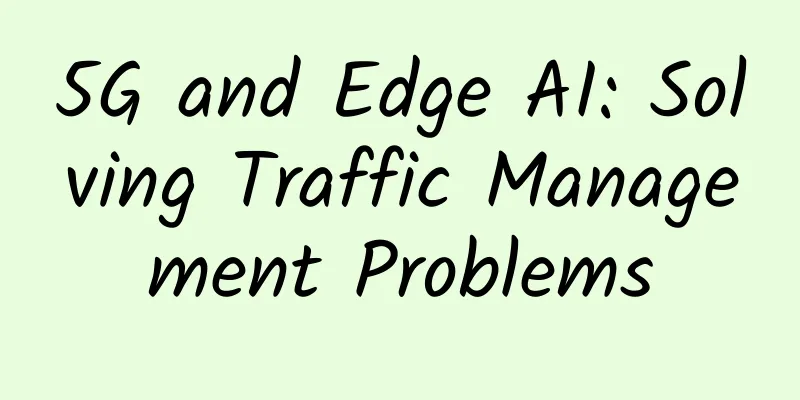5G and Edge AI: Solving Traffic Management Problems

|
The way we commute may have changed over time, but the way traffic is managed has not. The INRIX Global Traffic Scorecard reports that the world’s 20 most congested cities experienced a reduction in congestion time per capita of 164 to 210 hours in 2018. The exponential growth of vehicles in cities is at the core of traffic congestion. Improving public transportation is the solution, but at the same time, we also need to consider how to improve the efficiency of traffic management to improve the scene. Traffic management departments have tried to transform passive management into active traffic management, but have been limited by network speed and edge processing capabilities. 5G and artificial intelligence provide huge opportunities for traffic management. When 5G comes on the roadWith denser and more complex road networks, newer technologies, and larger data, 5G will provide greater visibility and control over traffic. This, in turn, will help to unclog traffic networks more quickly, further reducing congestion, eliminating knock-on effects, and making roads safer for all users. With 5G, edge devices will become more powerful in transmitting and processing large amounts of data through AI analytics servers, which can only benefit traffic management. With speeds up to 70 times faster than 4G, it will provide integrated visibility into the movements of all road users – people and traffic – allowing for better overall planning. With the help of a host of sensors, cameras and even drones, 5G transforms the road network into a set of miniature clouds, each of which can communicate with each other, including autonomous vehicles. The vast amounts of data generated by sensors in autonomous or self-driving vehicles can be effortlessly accommodated by 5G, enabling inter-vehicle and inter-sensor communications. Sensors in these vehicles will gather key information based on recorded observations to make decisions and change routes. Martti, an autonomous vehicle from VTT Technical Research Centre of Finland, has been tested to detect icy road conditions in advance and transmit 3D views between vehicles. Artificial Intelligence Solutions and Big DataThe power of artificial intelligence (AI) and big data combined with the benefits of 5G technology will provide a powerful solution that combines high reliability and ubiquitous network access. The low latency provided by 5G is key here, with AI models using real-time network information and historical data to detect the likelihood of an incident and instantly design an optimized response plan to deliver at high speeds. Using a combination of traditional and edge-based AI systems, traffic metadata from across the road network can be captured in real time. This combination of 5G and AI will be the answer to transforming traffic management over the next decade. It may also signal a much-needed boost for autonomous vehicles in collaborative connected systems. Let’s look at two specific AI-based solutions and their impact on vehicle activity. Artificial Intelligence and Smart Traffic LightsAI-based traffic light control will have a significant impact on vehicle activity, significantly reducing conflicts in vehicle movement and increasing road network capacity. An integrated setup for effective traffic management will involve an adaptive traffic light system, an edge system, and a backend monitoring system. Video captured using IP cameras is relayed to an edge-based AI system that analyzes the data before sending it to backend monitoring. A pre-trained deep learning model sends the processed information back to the adaptive traffic light in real-time to create traffic flow. With traffic lights adapting to changing traffic in real time, movement on the road can be controlled by traffic light timing, which can adjust itself. Changing traffic scenarios and timings of intersections can be shared through interoperable communications so that all intersections are prepared to optimize the approaching traffic flow. A pilot system deployed in Pittsburgh, Pennsylvania, reportedly reduced travel time by 26%, idling time by 41%, and emissions by 21%. Interestingly, adaptive traffic light systems also reduced total accidents and fatal accidents by 13-36%. Traffic Accident Artificial IntelligenceBecause incidents are unexpected and sometimes catastrophic, incorporating AI into a comprehensive, sustainable traffic incident management system with smart traffic lights can transform traffic monitoring. This is where the hybrid technology alliance comes in. Big data from IP cameras, GPS, cell phone tracking, detection vehicles, and loop detectors are merged to draw more precise inferences than when studying large amounts of information independently. AI algorithms then continuously and instantly analyze the data, fusing it to detect potential incidents. Traffic simulators can study archived and real-time data on the time and location of incidents to analyze the impact. AI models that predict the duration of incidents can also indicate specific points that require attention and the overall impact on the road subnetwork. In addition, deep learning models can explore correlations between intensity and overall impact, helping to prioritize incidents and their responses. The integration of data analytics helps test various traffic scenarios, from which effective, real-time, automated traffic incident response plans can be derived. In Delhi, sensors from more than 7,500 CCTV cameras, programmed traffic lights, and 1,000 LED signs collect real-time data that AI processes into instant insights that authorities use to improve traffic management. Data collected from citywide smart cameras installed in Milton Keynes, UK, is run on a deep learning model to predict traffic conditions 15 minutes in advance with 89% accuracy. Simplifying traffic managementTo deliver on the promise of 5G, road and transport network management systems will also need to evolve over time. Data from disparate sources will necessarily be more complex. The process by which all systems work together to respond universally and immediately needs to be precisely implemented. In the technological adaptability, it is important that intelligent network decisions are autonomous and easily understandable. This will provide room for human decision-making and intervention as well as technology when needed. While we may have passed a century since the world’s first highway was built, it is only now that the world is gearing up to drive this process forward. |
<<: Buildings are finding ways to incorporate 5G into IoT networks
>>: A graphic guide to selecting network equipment
Recommend
5G is coming soon. What preparations have the major equipment operators made?
With major telecom operators around the world exp...
What is the transport layer protocol?
Transport layer protocols are an important part o...
my country started IPv6 construction early but is still late. How will we roll up our sleeves and work hard in 2017?
As early as 2003, my country put the development ...
HPE Aruba Networking launches new AI network security and visibility products to effectively combat generative AI security threats
At the RSA Conference, HPE Aruba Networking annou...
In-depth study of principles - TCP long connection and heartbeat keep alive
Preface Many Java programmers may only have a thr...
IonSwitch: 20Gbps bandwidth/NVMe hard drive US VPS annual payment starts at $25
IonSwitch is a foreign hosting company founded in...
Network security protection under large-scale deployment of IPv6 - Seven questions and answers on IPv6 security technology
Due to its huge address space, IPv6 has a natural...
5G backhaul will become the next growth point in the field of optical communications
According to industry insiders, 5G mobile service...
Five signs SCVMM isn't right for your data center
Today, System Center Virtual Machine Manager (SCV...
DiyVM: Japan/US/Hong Kong CN2 line 2G memory monthly payment starting from 50 yuan
DiyVM is a Chinese hosting company founded in 200...
Take a look at Sigfox, LoRa, and NB-IoT: wireless transmission technologies in the era of the Internet of Things
Wireless communication technology is the transmis...
Insider information revealed! What magical operations did the operators' employees use to boost their performance at the end of the year?
According to the data of "Economic Operation...
Beijing Unicom and Huawei jointly launch intelligent accelerated learning broadband to reshape the family online education experience in the F5G era
[Beijing, China, April 23, 2020] Today, China Uni...
EtherNetservers: $14.95/year-1GB/40G SSD/1TB@10Gbps/Los Angeles & New Jersey & Miami & Germany data centers
While other vendors are offering KVM, EtherNetser...
Huawei Mate X: The Future of the Future
Looking back at the year 2019 that is about to en...









